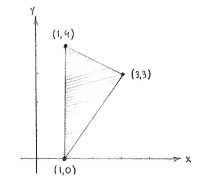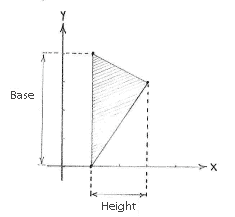Solution 2.2:9a
From Förberedande kurs i matematik 1
We can start by drawing the points \displaystyle \left( 1 \right.,\left. 4 \right), \displaystyle \left( 3 \right.,\left. 3 \right) and \displaystyle \left( 1 \right.,\left. 0 \right) in a coordinate system and draw lines between them, so that we get a picture of how thetriangle looks.
If we now think of how we should use the fact that the area of a triangle is given by the formula
Area= \displaystyle \frac{1}{2} (base)∙(height),
it is clear that it is most appropriate to use the edge from \displaystyle \left( 1 \right.,\left. 0 \right) to \displaystyle \left( 1 \right.,\left. 4 \right) as the base of the triangle. The base is then parallel with the y-axis and we can read off its length as the difference in the
\displaystyle y -coordinate between the corner points \displaystyle \left( 1 \right.,\left. 0 \right) and \displaystyle \left( 1 \right.,\left. 4 \right), i.e.
base \displaystyle =4-0=0. In addition, the triangle's height is the horizontal distance from the third corner point \displaystyle \left( 3 \right.,\left. 3 \right) to the base and we can read that off as the difference in the \displaystyle x -direction between \displaystyle \left( 3 \right.,\left. 3 \right) and the line \displaystyle x=1, i.e.
height \displaystyle =3-1=2.
Thus, the triangle's area is
Area= \displaystyle \frac{1}{2} (base)∙(height) \displaystyle =\frac{1}{2}\centerdot 4\centerdot 2=4 = area units.


